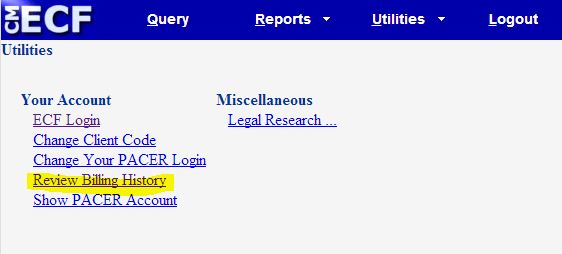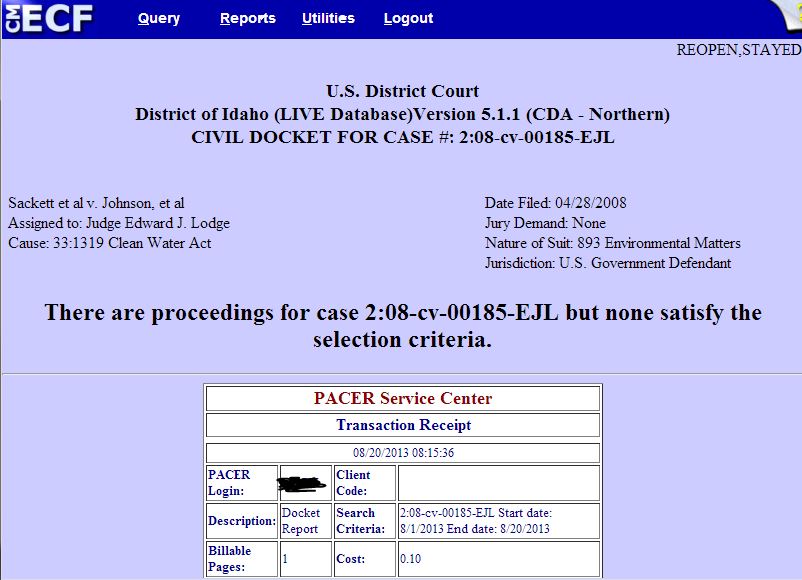Another great resource for finding court documents related to interesting and/or important court cases is the Courthouse News Service. Thanks to it, I discovered two separate court decisions about fee waivers for PACER and FOIA requests. I’ll talk about the FOIA case in this writing, and cover the PACER decision in a follow up.
In the first decision, Judge Emmet Sullivan ruled that a non-profit organization was not eligible for a fee waiver for a FOIA request, because, bluntly, it wasn’t popular enough. Or, to be more exact, the plaintiff, Cause of Action, couldn’t demonstrate a capability of disseminating the acquired information to enough people to justify the government absorbing the expense of meeting the FOIA request.
In the decision, Judge Sullivan wrote:
To show the requested information would increase understanding of the public at large, Plaintiff must demonstrate “in detailed and non-conclusory terms,” that it has the intent and ability to effectively convey the information to a broad segment of the public and therefore, the FTC, as surrogate for the public, should foot the bill for a fee waiver…Although requestors are not required to explain their dissemination plan with “pointless specificity” to satisfy this element, they must identify several methods of disseminating the information and provide some concrete basis upon which the agency can conclude that those methods are adequate to convey the requested information to a wide audience.
By law, we have access to certain government information via the Freedom of Information Act, but obtaining this information can be resource intensive for the government agency meeting the demand, and costly to the entity making the demand. In order to ensure as open an access as possible, the Freedom of Information Act includes provisions for fee waivers.
Whether an entity is charged a fee or not is based on a determination: fees are waived “if disclosure of the information is in the public interest because it is likely to contribute significantly to public understanding of the operations or activities of the government and is not primarily in the commercial interest of the requester”. People and organizations can ask to have fees waived, but they need to meet the two primary tests: that the requested information contributes to the public knowledge about how the government operates, and the requester doesn’t want the information for primarily commercial reasons.
Once an entity has proved it doesn’t plan on using the information for commercial purposes, then the fun part starts. To establish the public interest component, the government agency applies a 4-factor test to determine if the fees may be waived.
In Judge Sullivan’s decision:
First, requestors must demonstrate that the information they seek concerns the operations or activities of government. Second, they must demonstrate that the disclosure is likely to contribute to an understanding of the operations or activities of government. Third, they must show that the disclosure will contribute to an understanding of the subject by the public at large. Fourth, they must demonstrate that the information will contribute significantly to such understanding.
The court case decision encompassed three separate FOIA requests.
In the first request, Cause of Action was able to successfully “pass” the first, second, and fourth tests, but failed in the third.
Throughout its voluminous correspondence with the FTC regarding its first FOIA request, it identified only two methods of dissemination, which it discussed only in footnotes: its website and articles published by news media that have relied upon COA’s past work on other issues…Plaintiff did not provide any estimate of the number of people likely to view its website, nor did it demonstrate other ways in which it would disseminate the information itself, without relying on another source. Id. And although COA provided a string cite of articles authored and published by other outlets as a result of its past efforts to gather information on other topics, it specified no organizations which would disseminate this information.
Another fee waiver request was denied because it failed the third and fourth tests.
The Court finds that Plaintiff did not satisfy this third element for the same reasons that Plaintiff did not satisfy this third element for its first request: COA did not specifically
demonstrate its intent and ability to disseminate the requested information to the public. Regardless of whether or not the website was functional, Plaintiff made no attempt to explain how many people likely view its website and thus would likely view the requested information…Plaintiff has also not satisfied the fourth element of the test and shown that the information would significantly contribute to public understanding. Because the primary beneficiary of the requested information is Plaintiff, the information is not likely to significantly contribute to public understanding.
This decision concerns me because I do make FOIA requests, and then use the information in articles I publish primarily at my web sites. I also post the raw data online, here at Documents at Burningbird. I’ve not been charged, yet, for any of my FOIA requests; thankfully, because I have limited funds and if the charges are too high, I would have to abandon the FOIA request.
Do I now have to be concerned about the popularity of my sites before I make a fee request? If so, what is the threshold for popularity? And how do I demonstrate that I meet this threshold? Do I need to provide screenshots of my web page statistics? Is there some W rating, similar to the infamous Q rating, I must meet in order to be deemed sufficiently popular enough to justify the fee waiver?
Do I have to appear on radio or television in addition to the Web? Must I be a guest on the Daily Show in order to demonstrate my viability as a medium of information dissemination?
In addition to the ambiguity associated with determining which entity does, and does not, have the ability to disseminate information broadly enough, both the agency receiving the FOIA request—the FTC— and Judge Sullivan demonstrated a breathless lack of understanding about web technologies. True, Cause of Action didn’t help itself by not having a web site online at the time it made its requests. But if it did, it would most likely share one thing in common with my web site: the fact that its web pages are accessed by search engine bots that then incorporate what they find into search results in tools such as Google.
Is Google, then, sufficiently popular?
Open Google in your browser. Search for the court case, “Front Range Equine Rescue et al v. Vilsack et al”. Now, have I sufficiently demonstrated my ability to broadly disseminate information?
And what does it mean, to “disseminate information”? Evidently, it has something to do with the purpose and format of making the information available, in addition to breadth of delivery. Judge Sullivan stated the following in regards to Cause of Action’s request for fee waiver as representatives of news media:
Upon review of the administrative record, the Court finds Plaintiff did not satisfy the third element of the news media requestor definition. First, Plaintiff has not specifically demonstrated its intent and ability to disseminate the requested information to the public rather than merely make it available [emph added]. In EPIC, the requestor satisfied this element by indicating that its newsletter reached 15,000 readers and had been published every two weeks for the past eight years…Second, the administrative record does not show that Plaintiff’s activities are organized especially around dissemination. For a “representative of the news media” fee waiver request, the requestor should be identified by its activities rather than by its description
Here at Documents at Burningbird, am I making information available, or disseminating information? Must I have a newsletter, or is posting links for writings to Twitter, Facebook, and Google+ sufficient?
The Freedom of Information Act was created in order to ensure transparency in government. Though we shouldn’t encourage frivolous FOIA requests, nor insist that government agencies drop their other needed work in order to fulfill FOIA requests (or go broke trying to meet overly broad FOIA requests), when a legitimate, targeted request is submitted by an entity, we shouldn’t demand that the entity meet some arbitrary level of popularity in order to determine whether the fee should be waived or not. Neither should the entity arbitrarily be forced into supporting multiple media in order to justify fee waiver requests.
What we can take away from Judge Sullivan’s decision is that we do make a FOIA request, we’ll have to be even more cautious in how we word a request for fee waivers. We’ll need to demonstrate not only that the information is in the public interest, but also provide details in how we’ll ensure public access to the information. We’ll also need to, somehow, convey the purpose of the information access—that we’re disseminating the information rather than just making it available, especially if we’re representing ourselves as part of the news media.
(If I’m not part of the news media, can I just make it available? Am I hurting my FOIA fee waiver requests by having a site like Documents at Burningbird?)
Unfortunately, the difficulty we face composing fee waiver requests is compounded by the fact that the different agencies apply different “standards” when determining fee waiver eligibility, with some being quite open to the requests (USDA and generally the EPA), and others being less so (the FTC). Our efforts also aren’t assisted by judicial decisions that don’t reflect understandings about current technologies.




